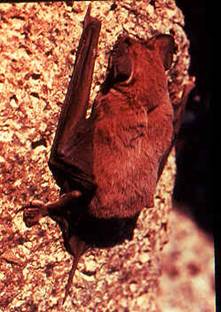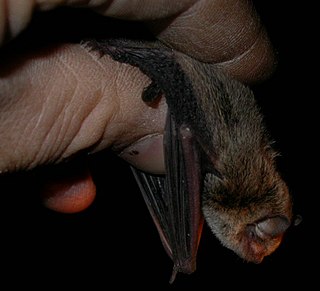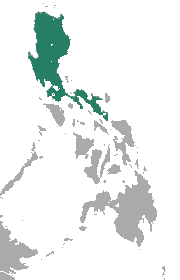
Megabats constitute the family Pteropodidae of the order Chiroptera (bats). They are also called fruit bats, Old World fruit bats, or—especially the genera Acerodon and Pteropus—flying foxes. They are the only member of the superfamily Pteropodoidea, which is one of two superfamilies in the suborder Yinpterochiroptera. Internal divisions of Pteropodidae have varied since subfamilies were first proposed in 1917. From three subfamilies in the 1917 classification, six are now recognized, along with various tribes. As of 2018, 197 species of megabat had been described.

Vespertilionidae is a family of microbats, of the order Chiroptera, flying, insect-eating mammals variously described as the common, vesper, or simple nosed bats. The vespertilionid family is the most diverse and widely distributed of bat families, specialised in many forms to occupy a range of habitats and ecological circumstances, and it is frequently observed or the subject of research. The facial features of the species are often simple, as they mainly rely on vocally emitted echolocation. The tails of the species are enclosed by the lower flight membranes between the legs. Over 300 species are distributed all over the world, on every continent except Antarctica. It owes its name to the genus Vespertilio, which takes its name from a word for bat, vespertilio, derived from the Latin term vesper meaning 'evening'; they are termed "evening bats" and were once referred to as "evening birds".

Henipavirus is a genus of negative-strand RNA viruses in the family Paramyxoviridae, order Mononegavirales containing six established species, and numerous others still under study. Henipaviruses are naturally harboured by several species of small mammals, notably pteropid fruit bats, microbats of several species, and shrews. Henipaviruses are characterised by long genomes and a wide host range. Their recent emergence as zoonotic pathogens capable of causing illness and death in domestic animals and humans is a cause of concern.

The Molossidae, or free-tailed bats, are a family of bats within the order Chiroptera. The Molossidae is the fourth-largest family of bats, containing about 110 species as of 2012. They are generally quite robust, and consist of many strong-flying forms with relatively long and narrow wings with wrinkled lips shared through their genus. Their strong flying forms allows them to fly 60 miles per hour using tail winds and at altitudes over 10,000 feet. This makes them unique among bats, as they are the only bat family that withstands the elevation. They are widespread, being found on every continent except Antarctica. They are typically found in caves, abandoned mines, or tunnels.

Horseshoe bats are bats in the family Rhinolophidae. In addition to the single living genus, Rhinolophus, which has about 106 species, the extinct genus Palaeonycteris has been recognized. Horseshoe bats are closely related to the Old World leaf-nosed bats, family Hipposideridae, which have sometimes been included in Rhinolophidae. The horseshoe bats are divided into six subgenera and many species groups. The most recent common ancestor of all horseshoe bats lived 34–40 million years ago, though it is unclear where the geographic roots of the family are, and attempts to determine its biogeography have been indecisive. Their taxonomy is complex, as genetic evidence shows the likely existence of many cryptic species, as well as species recognized as distinct that may have little genetic divergence from previously recognized taxa. They are found in the Old World, mostly in tropical or subtropical areas, including Africa, Asia, Europe, and Oceania.

The New World leaf-nosed bats (Phyllostomidae) are found from southern North America to South America, specifically from the Southwest United States to northern Argentina. They are ecologically the most varied and diverse family within the order Chiroptera. Most species are insectivorous, but the phyllostomid bats include within their number true predatory species and frugivores. For example, the spectral bat, the largest bat in the Americas, eats vertebrate prey, including small, dove-sized birds. Members of this family have evolved to use food groups such as fruit, nectar, pollen, insects, frogs, other bats, and small vertebrates, and in the case of the vampire bats, even blood.

Hepeviridae is a family of viruses. Human, pig, wild boar, sheep, cow, camel, monkey, some rodents, bats and chickens serve as natural hosts. There are two genera in the family. Diseases associated with this family include: hepatitis; high mortality rate during pregnancy; and avian hepatitis E virus is the cause of hepatitis-splenomegaly (HS) syndrome among chickens.

The eastern red bat is a species of microbat in the family Vespertilionidae. Eastern red bats are widespread across eastern North America, with additional records in Bermuda.

Brandt's bat or Brandt's myotis is a species of vesper bat in the family Vespertilionidae. It is native throughout most of Europe and parts of western Asia.

Vespadelus is a genus of Australian bats in the family Vespertilionidae.

The great roundleaf bat, also known as the great Himalayan leaf-nosed bat is a species of bat in the family Hipposideridae found in South Asia, Southeast Asia, and China. It gives birth to two young a year. It has been assessed as least concern by the IUCN.

The Luzon fruit bat is a species of megabat in the family Pteropodidae. It is monotypic within the genus Otopteropus. It is endemic to the Philippines. Its natural habitat is subtropical or tropical dry forest. It is threatened by habitat loss.

Miniopterus, known as the bent-winged or long winged bats, is the sole genus of the family Miniopteridae. They are small flying insectivorous mammals, micro-bats of the order Chiroptera, with wings over twice the length of the body. The genus had been placed in its own subfamily among the vespertilionid bats, as Miniopterinae, but is now classified as its own family.

Vespertilio is a genus of bats in the family Vespertilionidae. The common name for this family is vesper bats, which is a better-known classification than Vespertilio. They are also known as frosted bats.

Nyctophilus is a genus of the vespertilionids or vesper bats. They are often termed Australian big-eared bats or long-eared bats, as the length of their ears often greatly exceeds that of the head. This genus occurs in the New Guinean-Australian region.
Handbook of the Mammals of the World (HMW) is a book series from the publisher Lynx Edicions. The nine volumes were published from 2009 to 2019. Each mammal family is assessed in a full text introduction with photographs and each species has a text account with a distribution map and illustrations on a plate. This is the second major project by Lynx Edicions since the release of the Handbook of the Birds of the World in 1992. The chief editors are Russell Mittermeier and Don E. Wilson in association with Conservation International, the Texas A&M University and the IUCN. Don E. Wilson is also editor of the reference work Mammal Species of the World.

Bats are mammals of the order Chiroptera. With their forelimbs adapted as wings, they are the only mammals capable of true and sustained flight. Bats are more agile in flight than most birds, flying with their very long spread-out digits covered with a thin membrane or patagium. The smallest bat, and arguably the smallest extant mammal, is Kitti's hog-nosed bat, which is 29–34 millimetres in length, 150 mm (6 in) across the wings and 2–2.6 g in mass. The largest bats are the flying foxes, with the giant golden-crowned flying fox, Acerodon jubatus, reaching a weight of 1.6 kg and having a wingspan of 1.7 m.
Rhinolophus xinanzhongguoensis, the wedge-sellaed horseshoe bat or southwestern China horseshoe bat, is a species of horseshoe bat from China.















